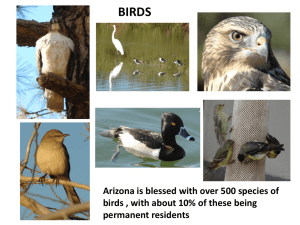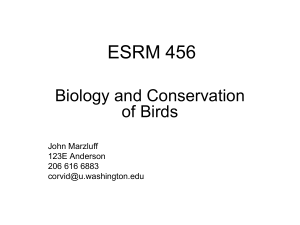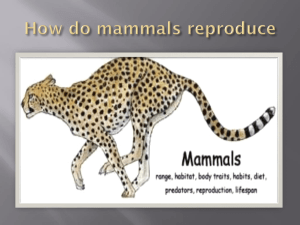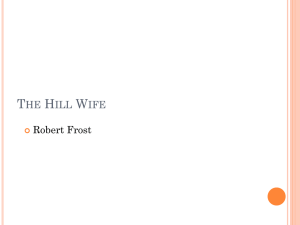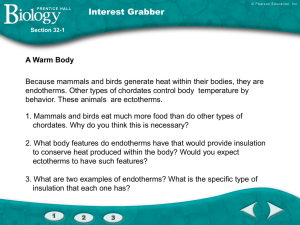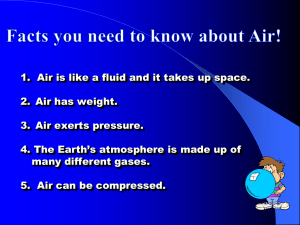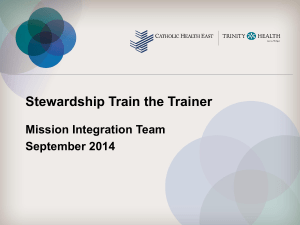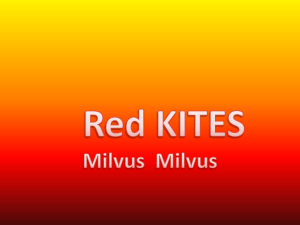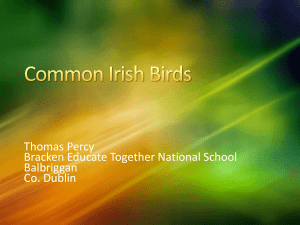Feathers
advertisement
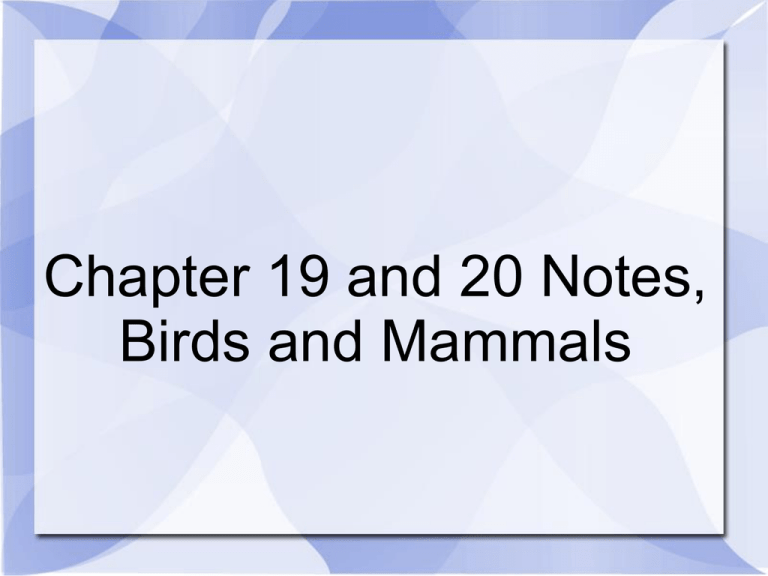
Chapter 19 and 20 Notes, Birds and Mammals Characteristics of Class Aves Forelimbs designed for flight in most birds. Epidermis is covered in feathers, except the hind legs which are covered in scales. No sweat or oil glands, but they do have a preen gland at the base of their tail, that they use to waterproof and protect their feathers. Bony skeleton that is filled with air cavities. Skull with keratin beak, but no teeth. Preen (Uropygial) Gland Characteristics of Class Aves 4-chambered heart, with separate pulmonary and systemic circulations. Endothermic, warm blooded. Respiration by air sacs. No urinary bladder, semisolid urine as waste. Sexes separate, internal fertilization. Amniotic egg, with hard calcareous shell. Eggs are incubated externally. Air Sac Respiratory System Feathers Almost everything about birds, with the exception of the flightless birds, is centered around two principles; more power, less weight. Feathers being made of keratin, are lightweight, yet amazingly tough and resilient. Most feathers are contour feathers, which are the feathers used for flight. Contour feathers emerge from the skin at the quill (calamus), and turn into the shaft (rachis), which bears numerous barbs. Feathers The barbs branch out diagonally from the shaft (rachis) to form the vane. There are several hundred barbs in a vane. Each barb has separate parallel filaments that branch off from the barbs called barbules. The barbules hook on to each other to keep the vane of the feather aligned. Each barb can have up to 600 barbules on each side of the barb. A single feather can have over 1 million barbules. Contour Feather Different Types of Feathers The three different basic types of feathers are Contour feathers (Flight feathers) Down feathers (Insulation feathers) Filoplume feathers (Sensory feathers) Feathers If the barbules become unattached, the birds preen their feathers to reattach them. Feathers, like hair, are dead once fully grown. Shedding or molting of feathers replaces old, worn out feathers. Molting usually occurs once a year, usually in late summer after nesting season. Flight and tail feathers are lost gradually and in pairs, so the molting doesn't impair flight. Peregrine Falcon Preening its Feathers Bird Skeletal Structure Bird's bones are pneumatic, which means they have air-filled cavities. The pneumatic bones make birds light, but they also play a role in the respiratory system of birds. This bone structure makes them incredibly light. The frigate bird has a 7-foot wingspan, but the skeleton only weighs a mere ¼ pound. In order to increase the strength of the hollow bones, the inside of the bones have cross members or struts like on an airplane. Frigate Bird Birds Pneumatic Bones Bird Skeletal Structure The orbits (eye sockets) of birds are unusually large to accommodate their excellent vision. Modern birds lack teeth. Some birds in the fossil record had teeth, like the famous archeopteryx. Teeth are very heavy. Instead birds utilize a muscular gizzard. The rib cage and sternum is rigid, not allowing expansion of the chest cavity for respiration. The rib cage and sternum must support the powerful wing muscles on the breast. Bird skulls Archeopteryx Skull Raven Skull Bird Skeletal Structure The sternum is keeled, meaning it has a very large surface area for muscle attachment. The clavicles are fused to form an elastic structure called the furcula, which stores elastic energy when the wing beats in flight. The furcula is the Y-shaped bone that we call the wishbone at Thanksgiving. The vertebrae and pelvis are also fused to absorb the shock of landing. Elastic Wishbone (The Furcula) Bird Skeleton Note the unusually large keeled sternum that attaches to the breast muscles Note the fused pelvis with the vertebrae called the synsacrum, which absorbs the shock of landing. Bird Muscular System If you have ever eaten a bird you know that most of the muscle in the body is on the breast. The largest muscle which pushes the wing down during flight is the pectoralis muscle. The pectoralis muscle also has an antagonistic muscle that brings the wing back up, but surprisingly it is not found on the back where one might expect. If it was, it would impair flight by making the bird too top heavy. Flight Muscles Instead, there is another muscle found underneath the pectoralis muscle called the supracoracoideus muscle and it has an ingenious rope and pulley system. Leg Muscles and the Perching Mechanism Muscles of the lower leg are greatly reduced because large leg muscles would affect a bird's center of gravity and it would make the legs vulnerable to cold. Birds have strong tendons that automatically clamp down when a bird is perched, allowing them to sleep while they are perched. Also, the talons on raptors, like hawks, eagles, and falcons are assisted by these tendons. The force of the strike causes the tendons to clamp down hard on its prey. The Perching Mechanism Birds Digestive System Birds lack teeth because teeth are too heavy. Instead, birds use a muscular gizzard that they fill with small stones and pebbles to grind food. Storage of food takes place in the crop. A chamber called the proventriculus is the actual stomach and it secretes gastric juice which chemically breaks down the food. Birds of prey like owls, form pellets of indigestible material (bones and fur) in the proventriculus, then they regurgitate them. Birds Digestive System Birds Respiratory System The respiratory system of birds is arguably the most efficient in the animal kingdom. It is no surprise considering how hard they have to work in order to achieve flight. For example, bar-headed geese migrate over the great Himalayan Mountains. They have even been observed flying over Mount Everest at 29,000 ft elevation. Not only that, but they do it all in one day without having to acclimate to avoid hypoxia. Birds Respiratory System The secret to their success is a one way (unidirectional) flow of oxygen, created by 9 air sacs distributed throughout the body, and tubes in the lungs called parabronchi. Air sacs connect to the bones via tubes. There are both anterior and posterior air sacs. It takes two full breaths for air to circulate the body. On the first inhalation, the oxygen rich air moves back to the posterior air sacs. Birds Respiratory System On the first exhalation, the air from the posterior air sacs moves into the lungs to deliver oxygen to the vascularized parabronchi. On the second inhalation, the air from the parabronchi moves into the anterior air sacs. On the second exhalation, the air from the anterior air sacs is removed from the body. The result is a constant flow of fresh air across the blood vessels surrounding the parabronchi. Birds Respiratory System Birds Respiratory System Wing Shapes There are four basic wing shapes found among birds to assist them in different ways. Elliptical (low aspect ratio) designed for low speeds while maintaining high lift and maneuverability. High-speed (tapering or sweep back wings) for high speeds and reduced turbulence. Soaring (high aspect ratio) for high lift and speed but low maneuverability. High-lift for carrying heavy loads at low speeds with moderate maneuverability. Wing Shapes Two wing designs that reduce turbulence or stalling of an airfoil is wing slots (or alula) or a sweep back tapering wing which reduces wing tip vortexes. Wing Slots and Wing Tip Vortexes Wing Slots and Wing Tip Vortexes Geese take advantage of the wing tip vortexes by flying in a V and catching the updrafts. Bird Migration Birds are the supreme migrators of the animal kingdom. The Arctic tern migrates to the Arctic Circle during the summer to breed. Then they migrate all the way to Antarctica during the winter. A total round trip distance of about 22,000-30,000 miles. The stimulus for migration is an increase of daylight in the early spring. This also stimulates an increase in gonad development, increase of fat storage, courtship and mating behavior and care of their young. Arctic Tern Migration Route Migration Navigation Understanding exactly how birds navigate is not entirely understood by scientists. Experiments have shown that some birds navigate by sight and recognizing landmarks. Experiments with homing pigeons have shown that the earth's magnetic field may help some birds to navigate. Small particles of magnetite have been detected in their neck muscles. Other experiments have shown some birds use the position of the sun and stars to navigate. Mating Strategies There are two main types of mating strategies in animals; monogamy, in which mating occurs with only one partner, and polygamy, in which mating occurs with multiple partners. There are many variations of the two types. Monogamy is rare in most animals, but very common with birds; approximately 90%. One reason why monogamy may be more common with birds than other animals like mammals is that birds lack milk, so parental roles are more equal. Mating Strategies The most common form of polygamy in birds is called polygyny. Polygyny is when one male has many female partners. This is a common practice with some members of the grouse family. Male sage grouse defend their breeding territories (called leks) from other rival males. The females choose the dominant male because he has the best genes. Sage Grouse Lek Nesting and Care of the Young Most birds build some type of nest in order to prepare a place to raise their young. There are two ways the young are born. Precocial young such as quail, fowl, ducks etc. are born covered with down and can run or swim as soon as their plumage is dry. Atricial young are born naked and helpless at birth and remain in the nest for a week or more. Most birds (the passeriformes) are altricial. Precocial Ducklings Altricial Chicks Class Mammalia Body covered in hair, reduced in some. Skin glands including, sweat, scent, sebaceous, and mammary glands. Turbinate bones in the nasal cavity that conserve water for endotherms and also give mammals an acute sense of smell. Teeth are diphyodont (deciduous or milk teeth), and also heterodont (varying in both structure and function). Turbinate Bones in Mammals Nasal Passages in a Reptile Class Mammalia Fleshy external ears called pinnae. 4-chambered heart and red blood cells are biconcave and nonnucleated. Secondary palate, which separates the air passages from the food. A muscular diaphragm for breathing. A highly developed, cerebral cortex. Internal fertilization, with development via a placenta in most, young nourished from milk. Hair All mammals have hair. Humans have very little, and whales usually only have a few sensory hair bristles on their snout. Hair is made from keratin, the same substance that makes up nails, claws, hooves, horns, feathers on birds, and scales on reptiles. Mammals have two kinds of hair that make up their pelage (coat); dense, soft underhair for insulation, and coarse, long guard hairs used for protection and camouflage. Hair Most animals undergo two annual molts. Many arctic animals like the weasels and snowshoe hare, have a brown to gray summer coat that is thin, and a white winter coat that is thick. Many mammals have unusual color patterns like the zebra's coat which confuses attacking predators, to the white spots on a fawn which imitates sunlight through the forest canopy. Green is a rare color for mammals, possibly in response to nocturnal behavior. Camouflaged Fawn Hair Many hairs are also used for defense and sensory purposes, like the quills on a porcupine, and the vibrassae (whiskers) found on a variety of mammals. An adaptation for nocturnal behavior. Horns and Antlers Horns are hard keratinized structures that grow from a bone on the skull and are not shed annually. They are found on members of the Bovidae family (sheep and cattle), and they are usually found on both sexes. Antlers are hard structures made of solid bone when mature, and are found in the Cervidae family (deer family). Antlers are shed annually, usually in the winter, and they regrow in the spring under a vascularized velvet. Horns and Antlers Integumentary (Skin) Glands Mammals have a complex integumentary system and skin glands. The four different skin glands are sweat, sebaceous, scent, and mammary glands. Sweat glands are for evaporative cooling. Scent glands produce pheromones for attracting mates, for marking territories or for defense (like in the case of a skunk). Integumentary Glands Sebaceous glands are closely associated with hair follicles and secrete an oily substance called sebum onto the hair and skin. Sebum protects and waterproofs the skin and hair of mammals. In most mammals, milk is secreted from mammary glands through nipples or teats. Monotreme mammals lack nipples and secrete milk into a depression on the mother's belly. Teeth The dentition or teeth in mammals are complex. Mammal's teeth vary in shape and form, relative to their function. These types of teeth are referred to as heterodont teeth. There are four basic types of heterodont teeth; incisors for snipping, canines for piercing, and premolars and molars used for shearing, slicing, crushing, or grinding. Heterodont Teeth Deciduous (Milk) Teeth Mammals grow two sets of teeth; a temporary set, called deciduous teeth, or milk (baby) teeth, and a permanent (adult) set of teeth. Only incisors, canines, and premolars are deciduous, molars are never replaced. Adaptations for Feeding There are four different ways mammals obtain their food. Their dentition varies with diet. Mammals can be either Insectivores, Herbivores, Carnivores, or Omnivores. Insectivores like shrews, moles, anteaters, and bats feed on small invertebrates like worms, grubs, and insects. Insectivores have teeth with pointed cusps, which puncture the exoskeletons of their prey. Insectivorous Teeth of a Shrew Adaptations for Feeding Herbivores can be divided into two groups. The first group is the browsers and grazers like the ungulates (hoofed animals like the horses, deer, antelope, cattle, sheep, and goats). The second group is the gnawers like the rodents and rabbits. Rodents have chisel-like incisors which continue growing for life and must be worn away to keep pace with their continual growth. Herbivore Skulls Adaptations for Feeding Herbivores also have the added challenge of breaking down cellulose, the structural part of plants. Vertebrates lack cellulases (digestive enzymes for breaking down cellulose). Herbivores harbor anaerobic bacteria and protozoans in their digestive systems that can produce cellulases. In some herbivores, such as horses, rabbits, elephants, some primates, and rodents, the bacteria are found in the cecum. Adaptations for Feeding In some non-ruminant herbivores like the lagomorphs (rabbits and hares), much of the nutrition is lost because fermentation of the cellulose occurs after the small intestine. In order to compensate, rabbits reingest their fecal pellets in order to extract as much of the nutrition from their food as possible. This type of feeding strategy is referred to as coprophagy. Ruminants (cattle, goats, sheep, deer etc.) have a four-chambered stomach. Adaptations for Feeding The first of the four stomach chambers of a ruminant is called the rumen. The food is broken down by bacteria in the rumen and is formed into small balls of cud. When the animal lays down to rest, it regurgitates the cud into its mouth to chew it into smaller pieces. Then the cud is reingested and it passes back through the rumen. Then it passes into two other chambers referred to as the reticulum and omasum, where water and some of the nutrients are absorbed. Adaptations for Feeding The remainder of the food products are passed into the last chamber, called the abomasum and small intestine, where enzymes are secreted and normal digestion occurs. Because there is very little nutrition obtained from vegetation, herbivores have to consume large quantities to obtain their nutrition. Large African elephants have to consume as much as 300-400 lbs. of vegetation a day! Adaptations for Feeding Carnivores, like canines, felines, and members of the weasel family, are well equipped with large canine teeth and carnassial cheek teeth that are designed for tearing flesh and meat. Their digestive tracts are short compared to the herbivores, and their cecums very small since their food is easily digestible. Omnivores (bears, pigs, raccoons, rodents, primates) have digestive tracts and teeth that allow them to eat both plants and animals. Digestive Tracts of Mammals Dentition (Teeth) of Mammals Reproduction in Mammals Most male mammals are fertile year round, however mating is restricted to times of fertility in females. Fertility in female mammals runs in periodic cycles referred to as estrus cycles. Only when a female mammal goes into heat or estrus, may she successfully breed. There are three different methods of breeding found in mammals. One group of mammals, the monotremes, are oviparous (lay eggs). Monotremata (Duck-Billed Platypus and the Echidna or Spiny Anteater) Reproduction in Mammals Marsupial mammals are viviparous, but the young are born underdeveloped, live in the mother's pouch for a long period of time known as the lactation period, and they drink milk in their mother's pouch. Placental mammals are viviparous, but the young remain attached to the placenta for a long period of time known as the gestation period. After the young are born, the lactation period is shorter than that in the marsupials. Marsupial Mammals
